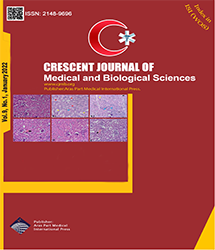| Original Article | |
| The Comparison of the Early Outcomes of Perimembranous Ventricular Septal Defect Closure by Two Different Methods: Transcatheter and Open-Heart Surgery in the Northwest of Iran | |
| Ali Rafiei1, Akbar Molaei1, Ahmad Jamei Khosroshahi1, Mahmood Samadi1, Shamsi Ghaffari1 | |
| 1Cardiovascular Research Center, Tabriz University of Medical Sciences, Tabriz, Iran | |
|
CJMB 2022; 9: 038-042 DOI: 10.34172/cjmb.2022.07 Viewed : 3642 times Downloaded : 2892 times. Keywords : Ventricular septal defect, Open-heart surgery, Transcatheter, Outcomes |
|
| Full Text(PDF) | Related Articles | |
| Abstract | |
Objectives: Ventricular septal defect (VSD) is the most common congenital heart disease (CHD) (40%). Traditionally, VSDs have been repaired surgically; however, recently VSD closure by device has been developed. This study aimed to compare these two methods in terms of effectiveness, outcomes, and complications. Materials and Methods: This study was conducted on VSD patients who were treated by either surgery or trans catheter technique in Madani Heart Center from March 2011 to March 2017. The required data regarding effectiveness, outcomes, and complications were recorded based on the patient"s documents. The extracted data were analyzed by SPSS version 18.0. Results: A total of 93 patients were enrolled (43 patients in transcatheter [A] and 50 patients in open-heart surgery [B] group) in this study. The gender distribution was approximately the same. The mean age of group A was 10.55 years while it was 8.8 years for group B. The duration of ICU and hospital stay, total hospitalization cost, and frequency of blood products transfusion were significantly lower in group A than in group B. However, postoperative pacemaker insertion, arrhythmias, thromboembolism, and mortality rates did not show any significant difference between the two groups. The success rates in group A and B were 97.7% and 96%, respectively. Conclusions: The results of our study demonstrated that open-heart surgery, due to its nature, required longer hospital and ICU stay, higher cost, and higher blood transfusion rate than transcatheter therapy, but it was associated with similar complications and success rates. Therefore, device closure in appropriately selected patients is recommended as an alternative to the surgical approach. |
Cite By, Google Scholar
Google Scholar
PubMed
Online Submission System
 CJMB ENDNOTE ® Style
CJMB ENDNOTE ® Style
 Tutorials
Tutorials
 Publication Charge
Medical and Biological Research Center
About Journal
Publication Charge
Medical and Biological Research Center
About Journal
Aras Part Medical International Press Editor-in-Chief
Arash Khaki
Deputy Editor
Zafer Akan


















